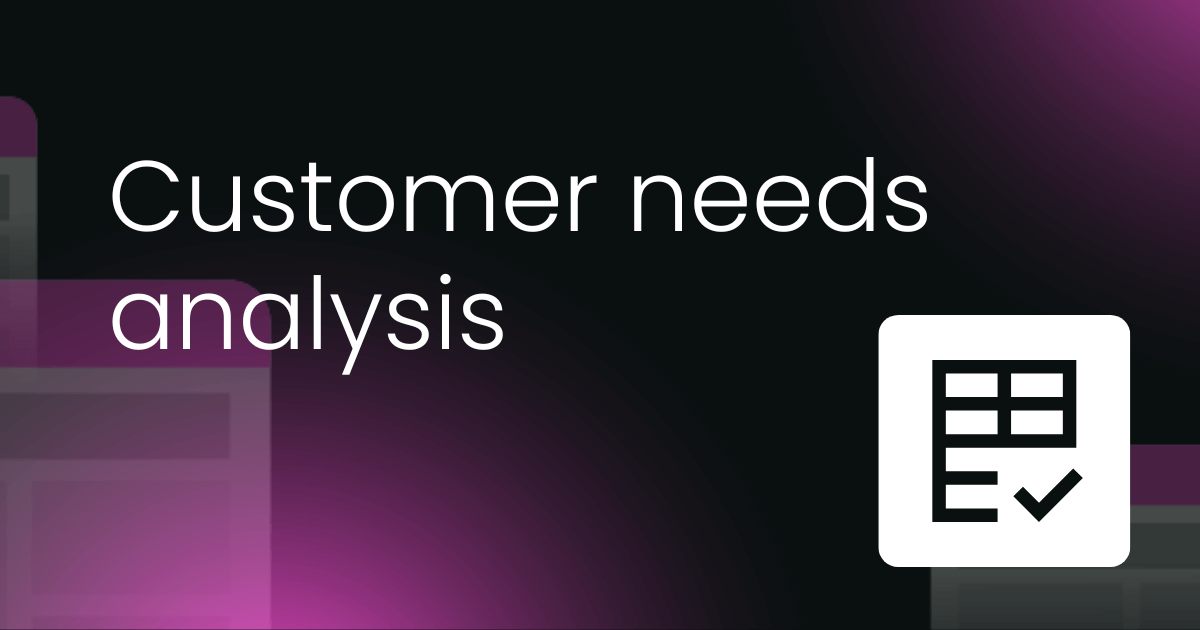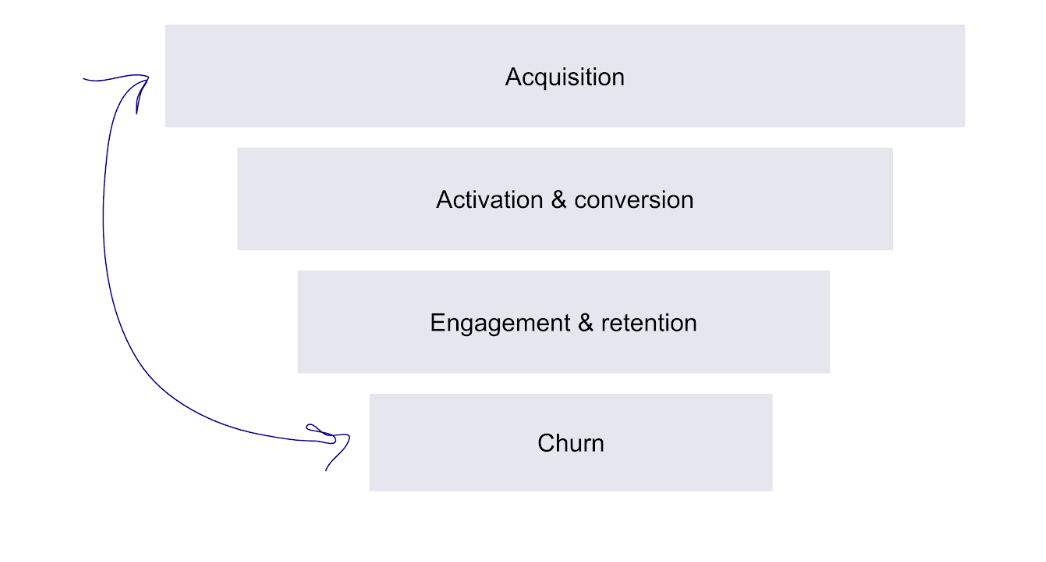Lawrence Chapman, a Senior Copywriter for our sister community, Product Marketing Alliance, wrote this article identifying and dissecting customer needs and how best to incorporate them into your business strategy.
While it's written with the intended audience of product marketers, we thought the sentiment of this article is perfect and will ring true for PMMs and CS professionals alike. 👇
There are three certainties in life: Death, taxes, and product marketers being reminded to address their customer needs.
Sure, you can be easily forgiven if you’re sick of hearing this time and time again. After all, it’s a message seemingly being played on a continuous loop, and it ain’t gonna lose its momentum anytime soon.
And with good reason. After all, a customer base is at the heart of every business, driving sales and propelling organizations to the next level.
Without them, we wouldn’t exist. Period.
So follow our advice as we look at:
- How to identify customer needs
- The most common customer needs and,
- How to meet them
What are customer needs?
There are times when we act impulsively and buy something on a whim. We’ve all been in the scenario when we’ve been at the mall with zero intention of buying something and ending up wasting money on a horrific shirt that’s confined to the wardrobe, never to see the light of day.
However, the majority of the time, customers buy products or services because there’s a genuine need and reasoning behind their purchase.
Let’s say the customer’s lawn is looking like Tarzan’s Africa, and they’re keen to transform it into their very own Garden of Eden. They’ll need a lawn mower and gardening equipment to resolve their problem.
So, customer needs can be defined by what a customer wants and needs when they’re set to interact with your business, your competitors, or when they’re searching for a product or service you may be able to offer them.
Product marketers need to make sure they’re in a position whereby they can cater to the requirements of customers who fit their buyer personas. Let's face it, if you can’t offer the solution to their problem, they won’t hang around until you’ve got your ship in order. They’ll waltz to your nearest competitor, who’ll be more than happy to benefit at your expense.
Which prompts the million-dollar question: which methods are used to identify customer needs in the first place?

Customer needs vs. wants
Customer needs are essential and most of your customers will have the same needs from your product. There is usually a hierarchy of needs, so the most important needs should be filled, and so on.
Customer wants, on the other hand, are unlimited and can arise from needs. For example, the need to eat dinner may lead to wanting a McDonald’s burger. Wants also compete with each other for the limited resources of the customer.
And perhaps most importantly, wants are not universal across your customers. You may want to use your customer segmentation to split customers by their wants.
How do you identify customer needs?
Make no mistake, understanding your customer's needs isn’t merely a case of throwing mud and seeing what sticks. A range of methods is used by companies to ensure they’re not barking up the wrong tree and offering customers products that are way wide of the mark.
But this doesn’t mean it isn’t possible to introduce ways that’ll give you an indication of what customer needs you should be honing in on - and as usual, we’re going to ease your worries and give you a whistle-stop tour of what you need to know.
Hakuna Matata.
Focus groups
Sometimes, you need to turn to the art of conversation to discover what you want to find out, in which case, what better way to pick the brains of your customers than focus groups?
Focus groups are a market research method whereby you interview a group of people who are representative of your target audience.
Granted, a breadth of valuable information can be gained by using data, but addressing your prospective customers directly brings a whole new perspective on what they want in terms of features, price points, and so forth. You can even grill them on things they don’t like about products provided by competitors and use this feedback to either develop an existing product or design an offering that’ll blow their socks off - figuratively speaking, of course.
Focus groups provide the perfect backdrop for a frank, honest discussion with your customers. While you may not necessarily like some of the feedback you receive, in many ways, that’s the point of conducting these sessions - to iron out any imperfections and be sure you’re providing a solution your customers love.
Previously, it may have been difficult to get a sample together to survey a physical location, particularly given the circumstances surrounding COVID-19. Yet this needn’t stop you in your tracks. Surveys can be sent via email or post, and with video platforms such as Zoom, you could even hold a virtual meet - the possibilities are endless.
Working on a budget? No worries - Google Forms is an awesome tool you can use for free.
So, wear your thick skin and set the ball rolling.

What is the importance of customer needs?
You get feedback
You might know the product inside and out but you probably don’t use it daily as they do. Maybe they just want a more condensed version of your existing user manual. Maybe they want a whole new feature added. If you don’t ask you don’t know.
Remember, no matter how great your solution is now it can always be better, and picking up snags and customer wish lists is the single best way to take it to the next level.
You can act faster
The more often you check in with customers the quicker you can pick up on any flaws, issues, or demands, and the sooner you identify things like that the sooner you can take action. That means happier customers, less churn, a step up on your competition, and more sales. And now, not later.
Keep in mind: for every customer who bothers to complain, 20 others remain silent.
You get buy-in
It’s easier to get the go-ahead on a new campaign, feature, or product if you’ve got concrete evidence supporting the why. That’s not to say you have to go and invest $$$$$s just because one customer said they’d quite like feature X adding to product Y, but keep a physical track of your conversations and if a trend emerges use it to support your argument.
You shape your campaigns
If one person’s thinking it others almost certainly are too, so the tidbits of knowledge you pick up during your chats could even shape future campaigns.
For example, let’s say you’re a CMS provider. Currently, your main marketing line is that your solution is “incredibly intuitive with drag-and-drop-style building features”. However, having spoken to a tonne of customers now, the selling point seems to be shifting towards its built-in SEO capabilities. Could there be a new campaign slant in it to attract more prospects?
Find out how you’re doing
Quantitative data is great and gives you a real insight into how products and campaigns are performing, but there’s nothing quite like qualitative research. It adds meat to the bones and helps you understand the reasons and emotions behind the numbers.
Why is page A the most visited in our app? How come people aren’t finding their way to feature B? Why didn’t campaign C work? Why was campaign D so successful? How can element E of feature F be improved? All answers you can get from direct communication with your customers.

Should you market to current customers?
Why market to current customers?
Adam Thomas, PM expert, shares why we should market to current customers.
“Sure, it’s easy to give lip service to our current customer base.
“It's easy enough to proclaim: 'We are customer obsessed', or a variation of it, is somewhere in your company’s mission statement, and it may be something that gets talked about during an offsite but think about how often you’ve talked to current customers in a proactive way.
“We usually talk to our customers reactively, in fact, if I look in your customer conversation tool (think Intercom) my guess is that any and all proactive conversation is in sales or retention. The 'why' is simple - our incentives are aligned that way - Net Churn and Activations are going to get eyes immediately when talking to leadership.
“That isn’t customer-obsessed, that is keeping the ship together. Why not talk to the current customer base? Sure the numbers aren’t sexy, but over the long term, you are guaranteed to learn the following:”
Question -> Metrics/Output
- Why does the customer trust you? Customer satisfaction, pricing analysis
- Why does the customer share your product? Referrals
- What would the customer buy from you? Follow-on products
“All of these things are good for business. All of them are going to make you look good. It's a win-win.”
Look after your existing customers
Aicha Zaa, Product Marketing Manager at Productsup, shares how to look after your current customers.
"The customer is king! As product marketers, we know that but how many of us really create strong processes around it?
"New markets are exciting to enter, and when your company is ready, new markets can lead to a big payoff. However, don’t forget the customers who are already loyal to your company, as they are your competitors' target market. They might have become brand advocates but now the work is in keeping it that way.
"To begin with, use customer feedback surveys to gather this information. Learn how your competitors offer to support their customers and weigh yourself accordingly to discover the scope of improvement. Customer support and satisfaction is the door to a profitable business as it helps businesses win their customer trust and maintain loyal relationships."
What is a customer needs analysis?
Customer needs analysis survey
The customer needs analysis is used to help companies figure out their position in their respective competitive markets and how they fare in terms of meeting their target customers' needs.
The survey should ask questions about your brand as well as competitors, what your customers know about your product, and brand awareness in general.
You could ask:
- Are there any positive and negative word associations with our brand?
- Which brand would you say is similar and/or competes with our brand?
Means-end analysis
Now you've conducted the customer needs analysis survey, you can use the answers to get a better picture of why your customers are your customers, as well as what makes your product or service stand apart from your competitors.
A means-end analysis uses those answers to determine the reasons why a customer would buy your product.
These reasons are then divided into three main groups:
1. Features: Your customer may purchase your product because of a specific feature, if you were buying a new phone, for example, the fact that it has a titanium, indestructible casing might be a draw.
2. Benefits: Your customer buys your product or service because of a benefit, they believe your product will offer them. For example, the customer might buy your phone because it wirelessly syncs to their other devices easier than competing models.
3. Values: A customer buys a product or service to help them fulfill an individual value. They may feel that by buying this phone they’ll communicate more frequently with loved ones who have the same handset.
Reasons for buying a product can be personalized to each customer and vary wildly, which is why it’s important to make note of the answers and group them into each category. From there you can identify exactly which motivating factor your product falls under and which perceived problem it solves!
This is a great way to find areas you need to improve in and discover new ways to one-up your competitors.

Customer feedback
After conducting customer surveys you will have loads of data on what your customers need - the problem is sorting through it. And that’s without counting all the unprompted customer feedback you could analyze.
You should try to sort this into rough groups relating to different major customer needs. Then you should look for common keywords in each of the groups and make a note of positive and negative emotions related to the feedback.
This can help you to get a sense of the key patterns in the data.
Common examples of customer needs
There is a whole range of different customer needs. For example, when we reach into our pocket and order an Uber taxi, this is driven by the need to go from A to B. Similarly, we may call for pizza delivery, and again, this is driven by our need to satisfy hunger.
The list is endless. We’ve categorized the types of customer needs below and divided them into two categories: product needs and service needs - have a nosey and familiarize yourself with them.
Product needs
Functionality
Given the choice, will your customer A) invest in a product or service that does half a job, and may not even solve their problem, or B) buy a product or service that’ll tick all the boxes?
No prizes for the right answer there. Customers need your product or service to function exactly the way they need it to, to rectify an issue or fulfill their desire.
Price
Whether it’s $20 or $2000, more often than not, buyers will be working on the constraints of a budget.
Remember, your customer will have a price point they won’t be able to surpass, so price accordingly.
Compatibility
Always ensure your product or service is compatible with your existing products on offer.
For example, when Xbox released its Xbox One console, a list of backward compatible titles from the previous console was released, meaning gamers could continue to enjoy their old favorites.
In doing so, you’ll keep your customers happy, and reduce the likelihood of them switching allegiances to your competitor.
Efficiency
Let’s face facts: we’re all impatient, and your customers are no different when looking for a product or service. They’ll always be attracted to a product or service that offers immediate gratification.
Performance
Nobody would visit a car showroom and buy a top-of-the-range Mercedes with square wheels. After all, why buy the undrivable car?
Similarly, your product or service needs to fulfill the duties required by the customer so they can achieve their goals.
Reliability
Sticking with the car motif, ever wondered why so many people buy Volkswagen cars? One word: reliability.
Products or services need to perform reliably, as advertised, whenever the customer uses them. Anything else doesn’t meet the customer's needs.
And that won’t cut the mustard.
Design
A product could have every feature on God’s green earth, but if it’s lacking aesthetically, chances are it won’t perform to its optimum potential.
When designing your product, always put usability at the forefront of your mind, because if it’s awkward to use, there's a strong possibility this will impact the customer experience and they could seek future solutions elsewhere, rather than give you a chance to redeem yourself.
Experience
Never overcomplicate things as far as using your product or service is concerned.
Remember, the customer has bought your product to simplify matters, not make things harder!
Convenience
Your customers are always looking for the most convenient solution to their problem - if they wanted to jump through hoops, they’d have joined the circus.
Offer a practical solution to their problem. They’ll be grateful for it.
Service needs
Accessibility
Nobody wants to constantly hear a pre-recorded message when calling customer service teams - it’s irritating, and sends out all the wrong signals.
You need to make your customer service support teams accessible, even if this means having multiple ways whereby they can get in touch with you, including chatbots, customer service numbers, and so forth.
Remember, word of mouth can make or break your company’s reputation, and if your existing customers turn the air blue if you’re not accessible, they’ll make their voices heard.

Empathy
However, let’s be positive and assume your customers won’t have any trouble at all contacting you.
Top tip: people getting in touch with customer support aren’t calling for a chat - they have a problem. So, if they’re disappointed, or express dismay for whatever reason, show empathy and understanding when providing help.
Be fair
Nobody likes being ripped off. Ever.
So, when you’re pricing your product or setting out terms of a customer contract, don’t be sneaky or sly. It’s not big, it’s not clever, and you’ll only wind up booking your customers a first-class, all-expenses paid trip to your nearest rival.
Be clear
Similarly, we can’t say how important it is to be crystal clear with your customers.
For example, if their cell phone tariff is set to increase by a couple of dollars, don’t spring a surprise on them when they open their next bill. Pick up the phone and let them know. They’ll appreciate your honesty, and it’ll only do good for your reputation.
Control
Everyone likes to feel some level of control and customers are no different when it comes to business interactions. Customers should feel empowered from start to finish and well after the sales. Make it easy for them to return products they don’t find satisfactory, play around with terms, and change subscriptions and you’ll have a customer for life.
Options
Consumers need options, after all, variety is the spice of life! Make sure you offer a variety in the form of products, features, subscriptions, and the way your customers can pay.
Information
Ever been in a scenario whereby you’re totally out of the loop?
If you haven’t, you’re not missing out: it sucks. If you have, you’ll know what we’re talking about, and shouldn’t subject your customers to the same treatment.
When people know about what they’re buying, this inspires trust; a relationship with no trust holds no credence, and sooner or later, you’ll shoot yourself in the foot.
Publish content geared to providing your customers with useful information they can use to make informed buying decisions and get the most from their purchases: blogs, instructional videos, and downloadable brochures - they’re all useful resources that’ll improve your overall service.
What are the most common customer needs?
We’ve unleashed a helluva lot of examples onto your plate in our previous section, but don’t panic; not every single one of the aforementioned customer needs will be particularly applicable to your circumstances.
To round off, here’s a bite-size list of the most common customer needs:
- Price
- Reliability and sustainability
- Risk reduction
- Usability and convenience
- Transparency
- Control
- Empathy
- Information

How to meet customer needs in 5 steps
Sometimes, circumstances stop your customer from meeting their needs with your products or services, and when you’ve devoted copious amounts of time and effort to developing a product or service you’re super-proud of, it can be difficult to stomach seeing customers go elsewhere.
But not to worry, some steps can be taken to address common pain points and have your customers eating out the palm of your hand.
Well, not literally, but you know what we mean. Here are some ideas:
1. Pool customer feedback from different sources to show multiple sides of the story
Everyone’s number one choice is always going to be one-on-one phone, video or in-person time but sometimes that’s easier said than done. So, here are all your options.
Call your customers
This will give you an open forum to get firsthand answers from the horse’s mouth and comes with a couple of pretty huge benefits:
Benefit #1: you can explore areas you might not have originally anticipated - if a customer’s answer sparks a question that wasn’t on your premeditated list, for example.
Benefit #2: you can gauge their inflections and this can say an awful lot about how a customer really thinks and feels. For example, let’s say you send out an email survey for people to complete. One of the questions is “What do you think about our analytics software?” and someone answers “Yeah, it’s good.”
Written down, that might not seem like a negative at a glance. But, what if that Q&A happened over the phone and it turned out there was a long pause while they had to think about it before they responded? And what if the customer’s voice was a bit deflated and unsure? Instantly, it becomes less positive.
In terms of organizing your calls, if you want time for a decent chat, it’s probably best to book appointments with your customers in advance - after all, no one likes a 20-minute phone call being sprung on them out of the blue. Giving people notice will also ensure they book time out to answer your questions with care and thought.
If you’re going with the ad hoc approach just be mindful of what time of the day you pick up the phone (remembering to take time zones into account, too). It’s thought between 8 am to 9 am and 4 pm to 5 pm is best, lunchtime, between 1 pm and 2 pm, is the worst - a hangry customer is not a happy customer!
Last couple of tips for this one:
Tip #1: remember to ask open-ended questions; one-word answers don’t tell you much. So, for example, instead of asking “Do you like our analytics software?” ask “Can you tell us what features, in particular, you like about our analytics software and why?”
Tip #2: people are busy and sometimes it takes a little nudge for them to part ways with some of their time for you. Try it for free first and be creative with your approach, but if you don’t get anywhere and you have the budget, think about attaching an incentive to the call - a simple voucher would do.
Get the info secondhand
Unlocking internal data is a time-old problem in the PMM community. We all know other departments (sales and customer service in particular) are sitting on a gold mine of data, but extracting it can be like getting water from a stone sometimes.
Unfortunately, there’s no quick or easy fix for this one and before you’re free and regularly fed with the info you need, an internal, cultural shift might be needed. Why? Because, rightly or wrongly, before said people in said departments go out of their way to help you, they need to understand why it’s important and how it benefits them.
The good news is that’s pretty easy to justify. Better products and features mean easier sales for your reps and fewer calls to your service departments. Winner.
Next, you need to make it as easy as possible. You’re busy, they’re busy, everyone’s busy, but the harder you make feeding back the less likely they are to stick to it, and they kind of hold the cards on this one, so it’s best to give them what they want - within reason, of course.
A couple of ideas include:
- Introducing a CRM whereby customer and prospect-facing teams can easily add important notes there and then. The later they recall what they’ve been told, the more likely they are to forget or miscommunicate key details.
- Investing in something like Slack and creating channels dedicated to feedback on things like ‘reason customer complained’, ‘reason prospect didn’t convert’ and ‘customer praise’.
- Sending someone from your team over to do random desk drops throughout the day to pick their brains in person.
Tip: if you want to really drive adoption of this kind of mindset it could be worth gamifying it, at least for the first quarter or two until it’s fully embedded. For example, you could offer a reward to the sales rep who provides the most and richest feedback each week.
Analyze phone calls
This could be with your sales, customer service, support, or onboarding teams and can be used in tandem or instead of (if you don’t get any co-operation) the previous point.
Admittedly, this option’s going to be a lot more labor-intensive but there are tools out there to help, like Gong, Chorus, SalesLoft, and Refract.
While the above tools are great the only snag is they’re predominantly for sales enablement, which doesn’t necessarily help decipher post-sale conversations. So, here are a couple of ideas on how to make the qualitative data you earwig on manageable and actionable:
- Divvy it up. That way, you can work your way through more without eating too much into any one person’s day.
- Set up a system. For example, you could create a scorecard with specific issues listed and then each time a customer raises something relating to that issue, scribble some of the buzzwords into the corresponding field.
On the flip side, you could monitor things people don’t say. For example, sticking with the CRM builder, if not a single person mentions your drag-and-drop builder as a pro, is it really as easy as you think?
Approach them in person
If you put on semi-regular events, trade shows or conferences for your customers use them as an opportunity to poach them for feedback - odds are, people will be a bit more giving with their time if they’re already at an event for them, by you. If all goes to plan, this could be a great outlet to get tonnes of first-hand feedback at once.
One caveat for this though is to make sure you’re speaking to the right person. If you’re B2B and want to understand how a customer finds your CRM system you need to speak to the person who uses it, not the person who foots the bill.
If all else fails...
You’ve still got lots of online options to gather quantitative and qualitative feedback, you’ll just miss out on some of the benefits that come hand-in-hand with actually hearing the responses.
Some popular tactics include:
- Sending out email, SMS, and in-app surveys
- Going through social media conversations (public and private)
- Adding a quick form to your Wifi network (commonly used in cafes, restaurants, bars, leisure centers, and hotels)
- Using feedback monitoring sites - like Google and Yext
- Recording visitors’ website sessions
- Reviewing live chat transcripts.
2. Map your insights back to your customer profiles and LTV
Karim Zuhri, GM & Chief Operating Officer at Cascade, share the rest of these steps for meeting customer needs.
“Quantify the JTBD and unmet customer needs. Don't just surface feature requests, instead focus on the problem the customer is trying to solve, remove bias, and assess alignment with your company’s goals and product strategy.”
3. Look at your funnel from acquisition to churn
“In order to gain alignment across different parts of the business, this is essential. It helps each team to begin to understand how actions they take at the top (and bottom) of the funnel can impact customers further on in their journey.

“Make sure that you have success metrics along the customer journey to measure product lovability at any time. Google’s HEART framework provides a set of 5 user-centric metrics that revolve around happiness, engagement, adoption, retention, and task success. Each metric aligns with a goal and a signal to let you know how well you’re tracking towards that goal.”
4. Get input to gain buy-in
“For instance, if the feedback is related to a new feature - ask the Product Manager’s thoughts on how it fits into their roadmap. Have they thought about this feature, from this particular vantage point? Allow them to publish their thoughts on the request so they feel they’re able to add input into the work that you do.
“Is this request something that we are already planning to ship? Is this issue related to a broader problem we’ve seen consistently across several sources? If we build this solution, how big is the impact? . Will it help with engagement, reach, expansion, or retention? What's the time to value? Is there a dependency that’s blocking us from taking action today?”
5. Let your customers know you are doing something about it
“Your roadmap is not a secret, but it doesn’t have to be set in stone either. Make your upcoming roadmap collaborative. Be transparent with your customers, discuss it with them, and understand what's critical and what a particular feature may mean for them. Be proactive in communicating not only what's coming soon, but also what you are considering longer-term.
“At its core, this program continues to help us bring customer feedback, information, and thoughts to the forefront of our business' conversations. Our aim was to consistently demonstrate, at scale, what our customers are saying and how they feel about our offer. We will continue to work towards this ever-illusive goal, and are confident that in the interim we’ve managed to ensure transparency and alignment across the business.
“Steve Jobs once said, “You've got to start with the customer experience and work backward to the technology.” Don’t put it off and say it’s someone else’s job. Implementing a customer-obsessed culture within your company is definitely your job as a product marketer. Don’t settle, drive internal conversations and be the voice of the customer, always.”
Liked this article?
If you enjoyed learning how to identify and act on customer needs, you might want to enroll in our Customer Success Leaders Fellowship course and spearhead your own strategy built on your customer's needs.
What to expect
- Non-stop, actionable insights
- Practical applications every week
- Total privacy with your closed CS leadership group
- Tons of networking opportunities
- Hands-on coursework activities
- Endless ideas from your peers and presenters
- Fuel to shape your gold-standard CS strategy



 Follow us on LinkedIn
Follow us on LinkedIn




